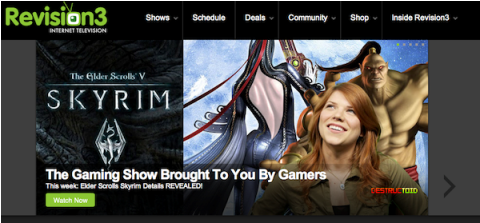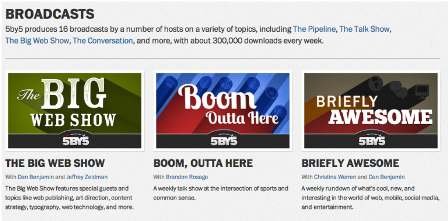 Are you thinking of becoming a podcaster? Are you curious about what it takes to become successful? If you answered yes, this article is for you.
Are you thinking of becoming a podcaster? Are you curious about what it takes to become successful? If you answered yes, this article is for you.
Podcasting is like any other content medium. To both provide value and keep your audience returning, it's best that you have a plan that maximizes your potential.
The most important feedback I can give potential (or current) podcasters is that you should take the medium seriously, possibly more seriously than you treat your blog. We'll talk about why that is throughout this piece, but for now, I ask that you consider podcasting not as a way to get cheap traffic, but as a professional media outlet.
This is not HAM radio. Podcasting is a now a million-dollar business, and it's showing signs of a resurgence, so much so that professionals are in the game, which means that if you treat your podcast as an amateur effort, then you're likely to fall short of your goals.
However, if you follow these four steps, you'll be on the road to podcasting success. So with that, let's get started!
#1: Decide on Show Frequency
I know it might seem strange that I list podcasting frequency first, especially because we've yet to discuss topic, format or any of the finer details. But there's a reason I do it, and it's this.
Just as a TV show runs on the same day and time every week, as does a radio show or even blog posting schedule, so should a podcast.
The most important factor in running a successful podcast is that you treat it as the professionals do, which means that you create a schedule and stick to it. Take a look at any major podcasting platform, such as 5by5, Mixergy or Revision3 and you'll find a show schedule with specific days for release.
As a podcast listener, I can tell you that there's nothing more frustrating than finding a good podcast only to realize that the posting schedule is erratic. When I can't rely on opening iTunes and seeing your new podcasts on a regular basis, then I quickly move on, and your podcast is removed from my feed.
Now, this doesn't mean you have to podcast every week. For new podcasters, I recommend a bi-weekly posting schedule, which should give you adequate time for pre- and postproduction, as well as generating new content often enough to keep your audience engaged.
As you get more comfortable, you're free to bump up the frequency to weekly, or even multiple times per week. The only caveat is that you post on the same day of the week or month and stay consistent with that schedule.
Lastly, post the schedule on your podcast's About page and make sure your readers know about it. This will help them ease in to your routine.

#2: Decide on Format: Audio vs. Video
Many new podcasters can't seem to decide whether they want to do an audio or video podcast. My answer to this is simple… do what you can.
If you're bad on camera, then no amount of high-quality production is going to make your podcast more entertaining. However, the same is true of your talent on the mic. The most important point here isn't whether your podcast is audio or video, but where you look and/or sound the most polished.
Get World-Class Marketing Training — All Year Long!
Are you facing doubt, uncertainty, or overwhelm? The Social Media Marketing Society can help.
Each month, you’ll receive training from trusted marketing experts, covering everything from AI to organic social marketing. When you join, you’ll also get immediate access to:
- A library of 100+ marketing trainings
- A community of like-minded marketers
- Monthly online community meetups
- Relevant news and trends updates
Sure, you'll get better as you go, and practice certainly helps, but looking at most video podcasts, you'll find that their production quality is very high and that the hosts are great on camera. If you don't have a great place to shoot video, then you might stick with audio. Also, if your podcast lends itself to a longer, more extended format (more on that soon), then audio is probably your best option.
Shows like Digg Nation and GeekBeat.TV are video podcasts, but also short, snappy and entertaining, which is why they do so well on video. Interview shows, such as This Week in Startups, also do well on video. This occurs because they're treated like talk shows rather than podcasts.
To help you make the decision, find other iTunes podcasts that do what you're planning to do and see what format they're using. That should tell you most of what you need to know.
#3: Determine Length Option
Podcast length is a tricky beast, and it's something you'll have to test often until you get a good feel for what works and what doesn't.
If you're the sole host, then I recommend keeping it to 15 minutes maximum. You can extend the time by adding a series of interviews, but even then I recommend that you keep it short enough so you don't exhaust a topic. If you close the recording feeling like you should've done more, then you probably stopped at the right point.

Discover Proven Marketing Strategies and Tips
Want to go even deeper with your marketing? Check out the Social Media Marketing Podcast! Publishing weekly since 2012, the Social Media Marketing Podcast helps you navigate the constantly changing marketing jungle, with expert interviews from marketing pros.
But don’t let the name fool you. This show is about a lot more than just social media marketing. With over 600 episodes and millions of downloads each year, this show has been a trusted source for marketers for well over a decade.
Even on co-hosted podcasts, such as Free Market Anarchy, I choose to keep the time between 12-15 minutes because it forces the hosts to move through topics quickly, which helps to keep the audience interested. The only long podcast I host is Lifebeat, which offers a mix of electronic music to keep the episode fresh.
That being said, many of the most popular podcasts I listen to—such as Internet Marketing for Smart People, hosted by Robert Bruce of Copyblogger, or Six Pixels of Separation by Mitch Joel—thrive on longer formats, often running well into 45-60 minutes.
What makes the difference here is the experience of the host in keeping an audience engaged, as well as the type of content. If your content requires in-depth discussion or you feel very confident on the mic, then it's possible that a longer format might work for you. However, there are very few new hosts who can pull this off, so use the long format with caution.
When it comes to podcast format, the key ingredient is the host, not the content. A bad host can make the best content boring, just as the best host can make crappy content exciting.
Going longer will give you the option to squeeze in more content (or sponsors), but keeping it short will at least give you a chance to guide your audience to the end of the discussion. There's nothing wrong with experimentation here, at least until you get it right.

#4: Determine Production Quality
This is the often under-appreciated part of managing a good podcast that can really make the difference between building an audience of 1 or 1,000.
By production quality, I'm referring to everything from how it sounds to how you run breaks in between segments.
Sound and Audio Quality:
I can't stress this enough—use good equipment! Don't try to sneak by with a cheap microphone or video camera. If your audience can't hear you, then they won't listen, and if you look fuzzy, they won't watch.
The Blue Snowball is a great entry-level microphone, and is what I use on all the BlueRize podcasts. With video, I recommend an HD camcorder, preferably one that isn't on a phone or Flip camera.
Intro and Outro:
People should know what your podcast is about within 30 seconds of listening. If they don't, or struggle to figure it out, then they're likely to tune out before you get started. Take the time to craft a good elevator pitch that explains your podcast in 1-2 sentences, and record it solo so you can easily add it to every episode.
Segments:
The Instance is a World of Warcraft podcast that runs heavy at an hour per episode, but it works because they break their podcast up into a mix of different segments. Jason Calacanis of This Week in Startups does the same thing… treating his show like something you would find on TV, rather than a mere video podcast.
In this case, think like a TV or radio show, not like a podcaster.
Postproduction:
Recording the podcast is only the first step—it's postproduction that helps give it that professional feel that you see on all great podcasts.
On Mac, I use GarageBand to edit out the awkward pauses and other mistakes I make while recording. On PC, I use Audacity, which is free.
Though I'm not one to edit out every “um” or “ah,” I do recommend that you take the time to even out sound levels and add your intro and outro music. If you add music over speech, make sure to reduce sound levels so that you can actually hear the speech. In most audio programs, this is called ducking.
If you don't have intro or outro music, I recommend that you buy some from Soundtrackster or Audio Jungle. It's an inexpensive way to make your podcast sound more professional.
I know, it's much easier to just record and upload, but resist the urge. I've tested the difference in doing this, and it's amazing. If you respect your podcast, so will your audience.

Final Thoughts
If you made it through the end of this piece, you're probably thinking that podcasting is more work than you thought it would be. This is good though, because now you can make the decision to start based on what it takes to be successful, rather than what it takes to simply exist.
In many respects, podcasting is more difficult than blogging, but ask any person who hates to write and they'll sing the praises of podcasting all night long. So really, it's a matter of what you like to do mixed with what you do best. All that being said, give it a shot, you've got nothing to lose!
What do you think? Have you done any podcasting? What do you recommend? Leave your comments in the box below.
Attention Agency Owners, Brand Marketers, and Consultants

Introducing the Marketing Agency Show–our newest podcast designed to explore the struggles of agency marketers.
Join show host and agency owner, Brooke Sellas, as she interviews agency marketers and digs deep into their biggest challenges. Explore topics like navigating rough economic times, leveraging AI, service diversification, client acquisition, and much more.
Just pull up your favorite podcast app, search for Marketing Agency Show and start listening. Or click the button below for more information.

